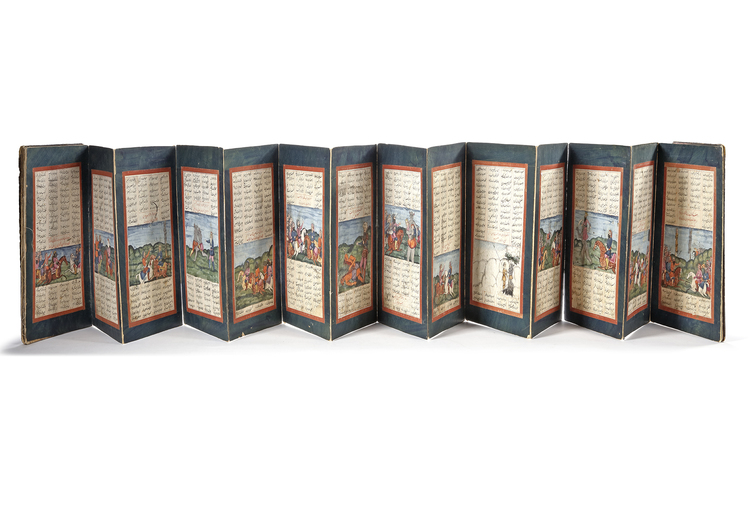Lot 198 AN ILLUSTRATED CONCERTINA ALBUM FROM FERDOWSI’S SHAHNAMEH, PERSIA QAJAR,18TH CENTURY
Persian manuscript on paper, 22 folios, presented in a concertina-style format, with gouache color on paper. Each page contains 13 lines, positioned above and below the painting, arranged in 4 columns, written in black nastaʿlīq script, with titles in red ink.
The vivid illustrations capture dynamic scenes of royal courts, heroic battles, and mythic quests—hallmarks of the Shahnameh's sweeping narrative. The palette is bold and expressive, reflecting the artistic sophistication of the Safavid period.
Catalogue note:
The Shahnameh—literally "The Book of Kings"—is the national epic of Persia, composed around (1010 AD) by the poet Abu’l-Qasim Ferdowsi of Tus. Spanning over 50,000 couplets, it is one of the longest epic poems in world literature and a foundational work of Persian culture, language, and identity. The Shahnameh recounts the mythical and historical history of Persia from the creation of the world to the Arab conquest in the 7th century.
The narrative unfolds across three legendary eras:
The Mythical Age: Filled with divine and heroic figures such as Kayumars, Zahhak, and Jamshid, reflecting Zoroastrian cosmology and ancient Persian lore.
The Heroic Age: The heart of the epic, featuring the legendary warrior Rostam and the tragic hero Sohrab, it dramatizes the battles, loyalty, and betrayal that define Iranian chivalry.
The Historical Age: A stylized retelling of Iran's historical dynasties, ending with the fall of the Sassanian Empire and the arrival of Islam.
The Shahnameh has been a constant source of inspiration for Persian miniature painting, particularly from the Ilkhanid, Timurid, and Safavid periods, with each manuscript illustrating the epic's most dramatic moments. These illustrated manuscripts were often royal commissions, intended both as artistic masterpieces and cultural affirmations of dynastic legitimacy.








